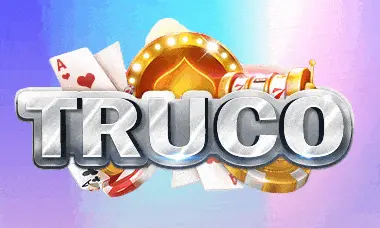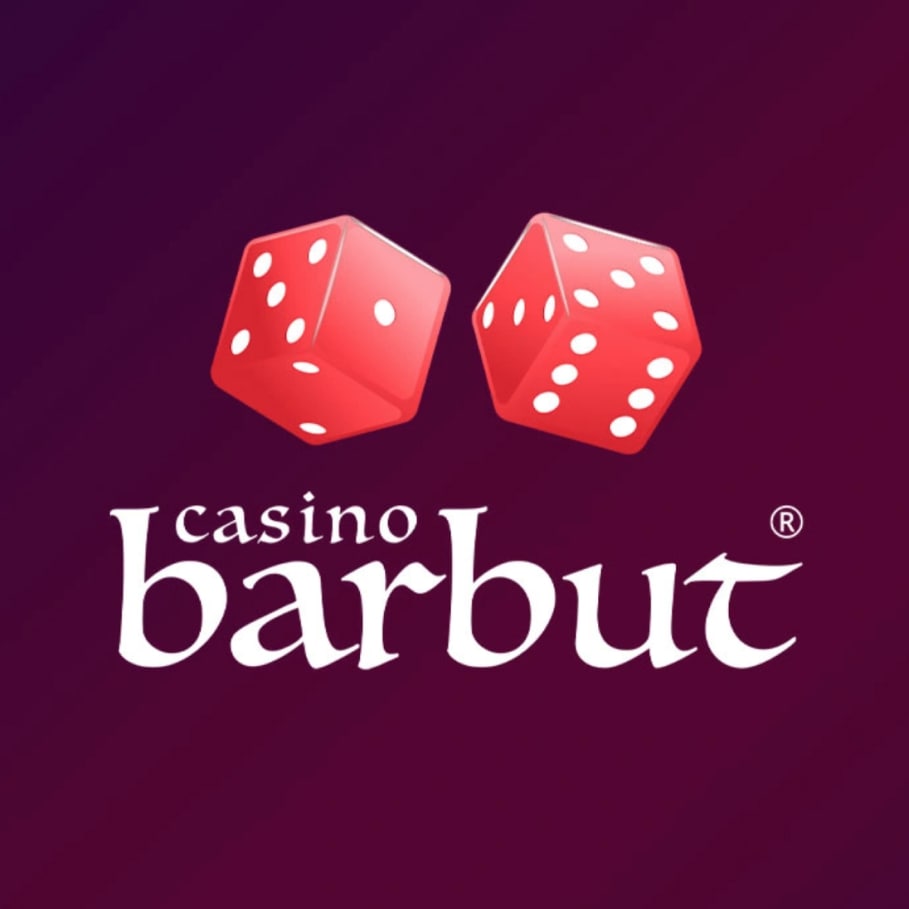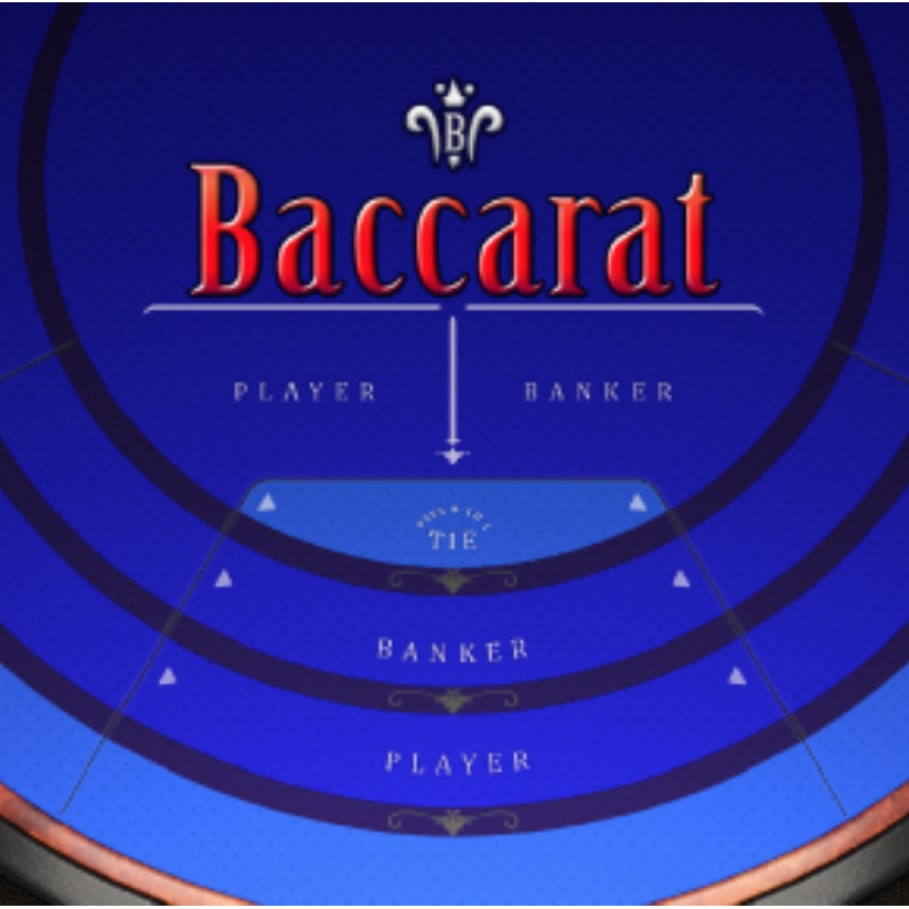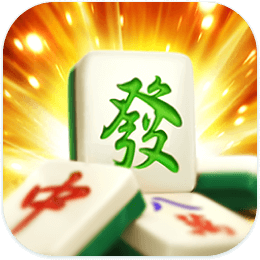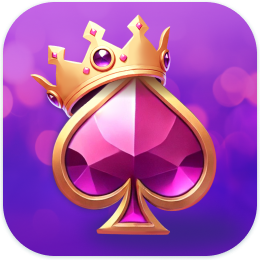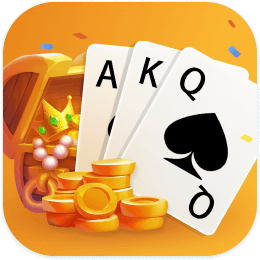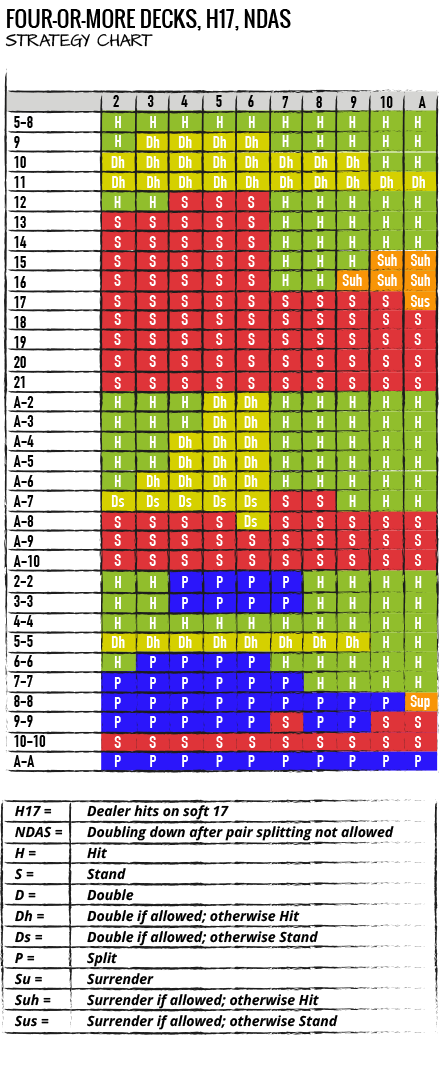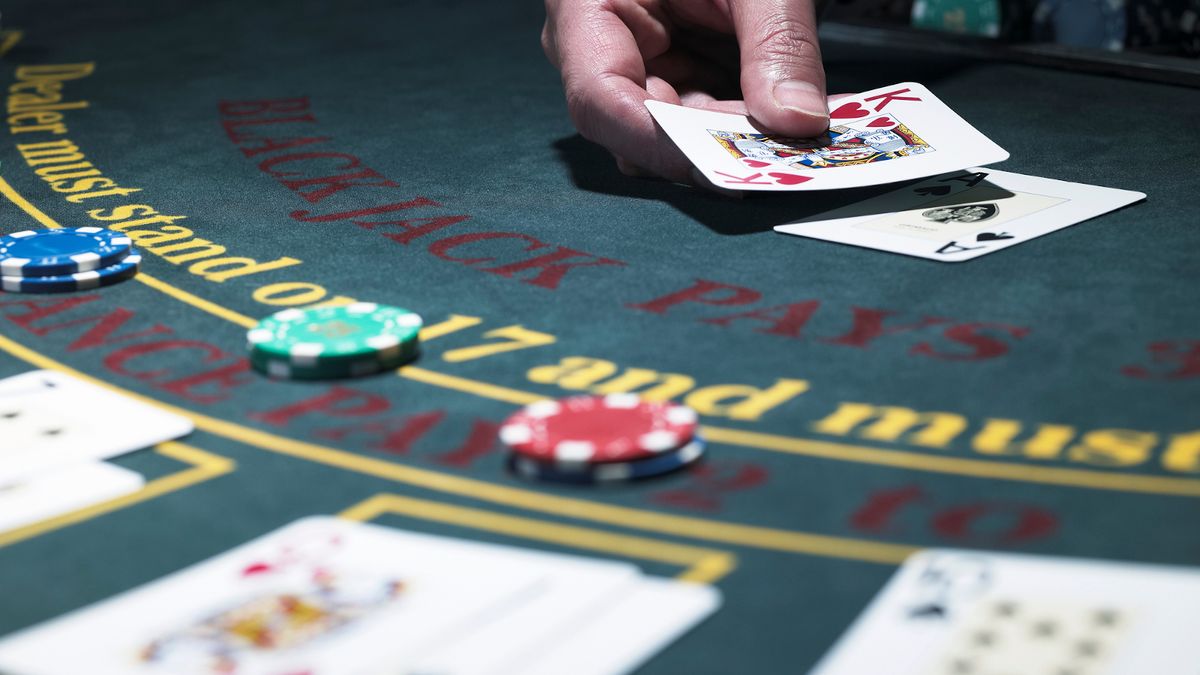Blackjack Charts

The following abbreviations are used in the blackjack strategy charts. You don’t have to memorize the abbreviations; they will become familiar to you after you begin to study the strategy charts
The objective of this chapter is to present the entire basic playing strategy for all blackjack games that you may encounter in two formats: a set of playing rules in a black-and-while table, and a summary of the strategy in a color-coded matrix chart.
Download Blackjack Basic Strategy Chart
You will be able to find an accurate basic strategy for any set of rules for the following games:
SINGLE-DECK BLACKJACK GAME
There are four strategy tables and four charts for single-deck games to play blackjack. The following abbreviations are used in the blackjack strategy charts. You don’t have to memorize the abbreviations; they will become familiar to you after you begin to study the strategy charts. (Note: The abbreviations also appear below each blackjack chart or table)

HOW TO USE THE STRATEGY TABLES
For each set of rules, you’ll find two different ways that the basic strategy is presented. The first is a black-and-white table and the second is a color-coded chart. Throughout the document I will refer to them as table and chart.
Note: The blackjack strategy charts lists the player’s two-card hand total and a possible multi-card hand total as a result of hitting a previously different hand one or more times. (In other words, play the multi-card hand as if it were an original two-card holding.)
For example, suppose you are dealt a 9-3 against a dealer’s 2 upcard in a six-deck game with Soft 17 and DAS. The strategy charts and tables state “hit.” You draw a 3 and you now have 15 against a dealer’s 2. If you look up the strategy for 15 against a 2 (table or chart), it states to “stand” against a dealer’s 2. And so you should stand.
For soft hands, since you can’t double down on more than two cards, any total that would have resulted in a double down, were it only two cards, now must become a hit or stand decision.
For example, suppose you are dealt an A-3 against a dealer’s 4 upcard. You hit (per the blackjack chart or table), and draw a 4. You now have A-3-4, which you should consider as A-7. If it were a two-card A-7, you would double down against a 4; however, since the A-7 is actually three cards, and you can’t double down, you stand.
Here’s another situation that could occur with pairs if the casino rules either don’t allow replits, or if they do, but you have split up to a maximum of four hands. For example, suppose you are dealt a pair of 6s, the dealer’s upcard is a 6, and the rules don’t allow replits. You split the 6s and on one 6 you draw another 6. Because you can’t resplit, you once again have to consider just the total of the hand (12) against the dealer’s 6 upcard and decide whether to stand or hit (for which, in this example, the blackjack strategy charts and tables state to stand). Suppose instead the casino rules allow replits and you draw two more 6s, giving you four hands, each one starting with a 6. On one (or more) of the 6s you draw yet another 6 (which could occur in a multi-deck game). Since you can’t split again, you must consider this hand as a 12 against a dealer’s 6 to determine how to play it.
Another point to keep in mind is that the strategy in the following tables and charts (also known as blackjack strategy card) does not consider the composition of the cards in the hand. For example, the strategy charts and tables state that you should hit hard 16 against a dealer’s 10 (assuming surrender is not offered), regardless if your 16 is composed of 10-6 or 8-4-4. (I’ll have more to say about composition-dependent strategy in Chapter 5.)
BLACKJACK STRATEGY CHARTS
The color-coded strategy chart contains the same information as the black-and-white table except it presents the strategy in the form of a color-coded strategy chart matrix. (The reason is that some players find it easier to learn the basic strategy with a blackjack strategy chart.) The dealer’s upcard (2 though Ace) appears along the top of the chart and the player’s hand can be found down the first column (grouped in order by Hard Hands, Soft Hands, followed by Pairs). For example, if you are dealt, say, a 12 and the dealer’s upcard is a 2, go down the first column to 12, go across the top (Dealers’ Upcard ) to the 2, and at the intersection of the 12 and the 2 is the letter H, meaning the correct strategy is to hit.
Let’s try another hand. Supposed you are playing a single-deck, h27, NDAS game and you are dealt an A-7 against the dealer’s upcard of 6. To find the correct strategy, go down the first column to A-7 and then go across the row until it intersects with the column labeled 6 (i.e., dealer’s upcard). You’ll notice the letters Ds at that intersection. The abbreviation Ds means double down if the rules allow it, otherwise, you should stand.
(Note: There is a listing of abbreviations at the bottom of each chart or strategy card)
ONE FINAL TIP:
notice that the charts are color coded. The background colors for each decision are:
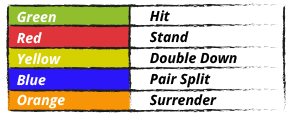

SINGLE DECK BLACKJACK, S17, DAS TABLE
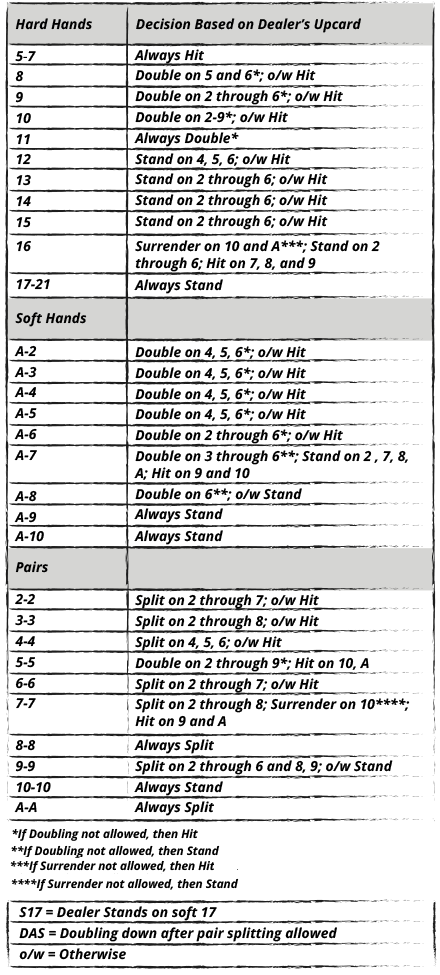
SINGLE DECK BLACKJACK, S17, DAS CHART
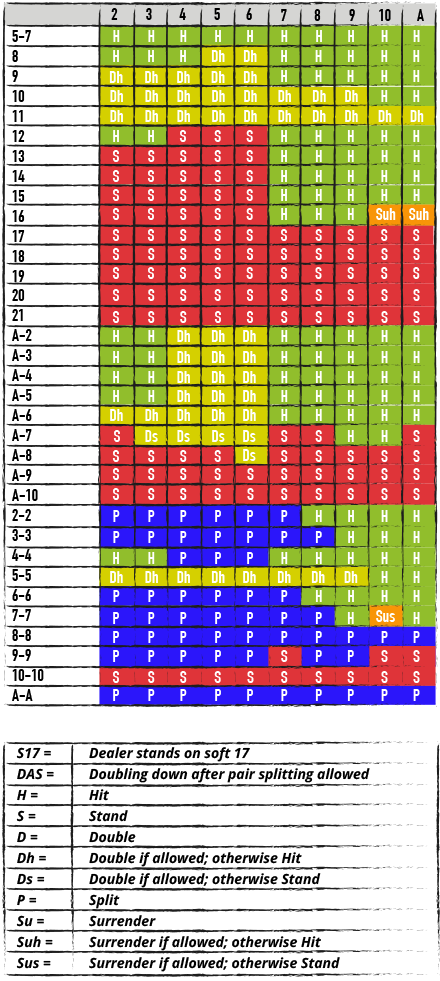
SINGLE DECK BLACKJACK, S17, NDAS TABLE
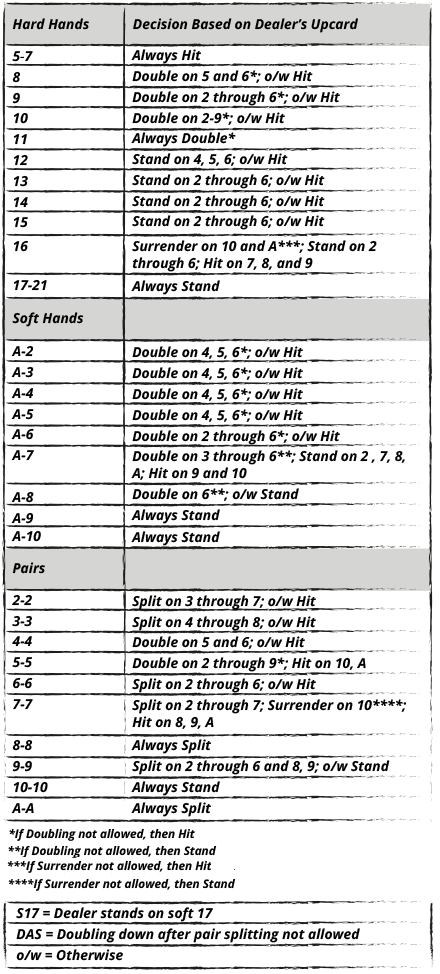
SINGLE DECK BLACKJACK, S17, NDAS CHART
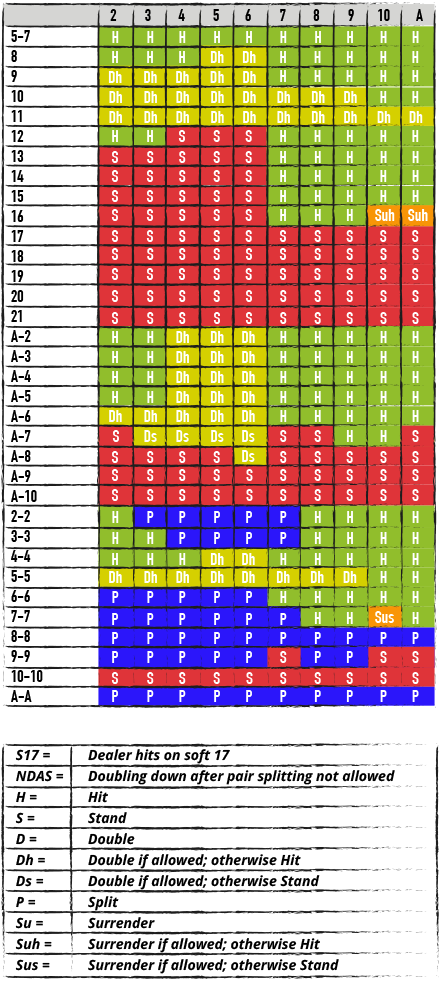
SINGLE DECK BLACKJACK, h27, DAS TABLE
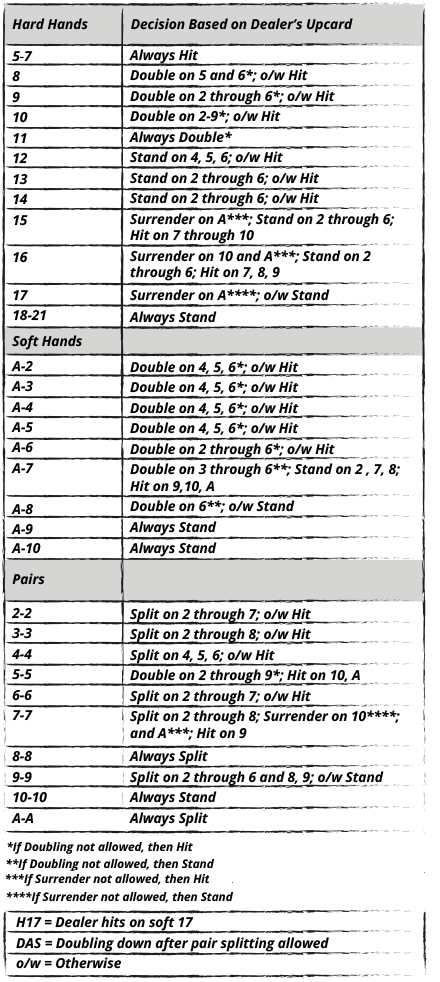
SINGLE DECK BLACKJACK, h27, DAS CHART
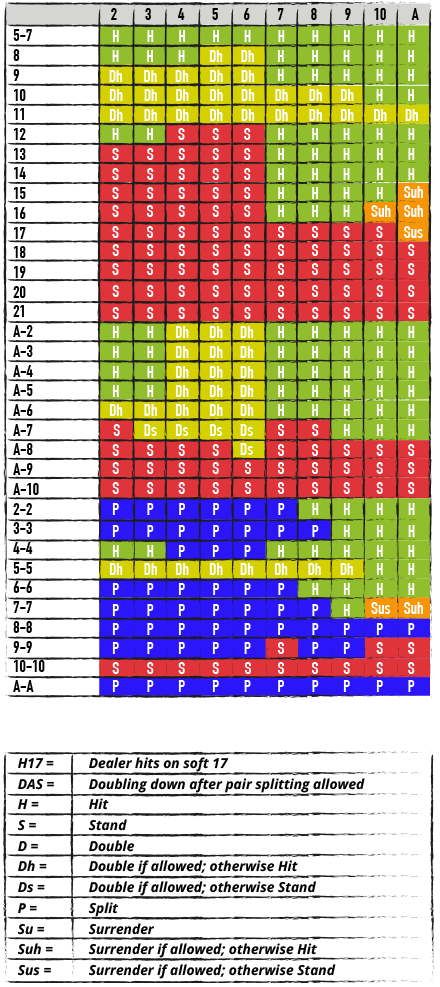
SINGLE DECK BLACKJACK, h27, NDAS TABLE
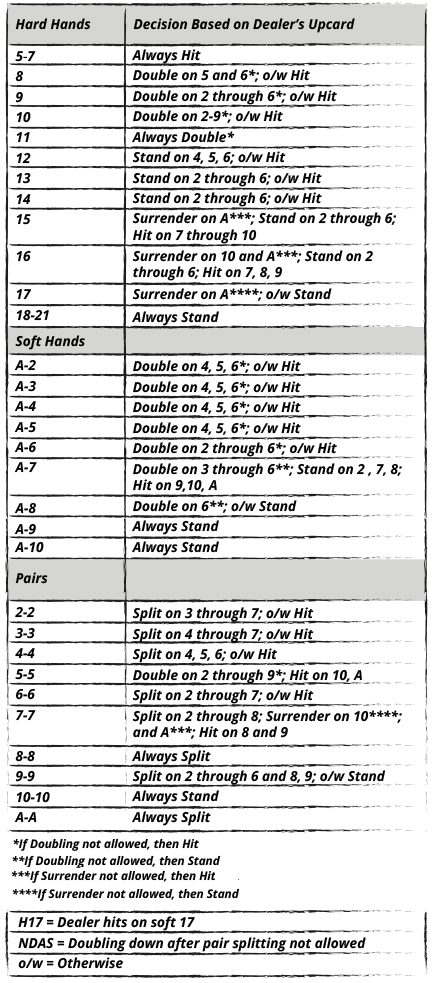
SINGLE DECK BLACKJACK, h27, NDAS CHART
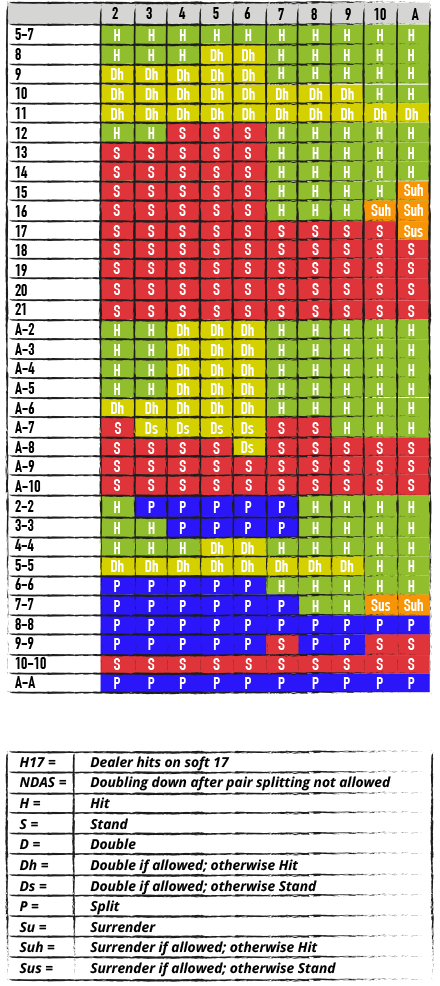
INSIDER TIPS FOR PLAYING SINGLE-DECK GAMES
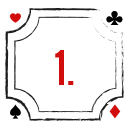 In most single-deck games, the dealers pitch the cards face down to players and a discard tray is not used (although a few casinos have used them). It’s rare when a casino will deal the cards face up to players in a single-deck game. Be sure you know the correct etiquette for holding your cards and signaling your playing decision to the dealer when playing in a single-deck game. (See Chapter 1.3.)
In most single-deck games, the dealers pitch the cards face down to players and a discard tray is not used (although a few casinos have used them). It’s rare when a casino will deal the cards face up to players in a single-deck game. Be sure you know the correct etiquette for holding your cards and signaling your playing decision to the dealer when playing in a single-deck game. (See Chapter 1.3.)
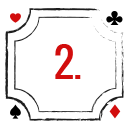 The basic strategy for pair splitting changes slightly when the rules specify NDAS vs. DAS. If you look at the pair splitting strategy in the strategy charts for NDAS vs. DAS you’ll see that you will split more times when the rules specify DAS vs. NDAS. That’s because you want to be more aggressive in splitting when you have the opportunity to double down after you split. For example, with NDAS, you split 3s against a dealer’s 4, 5, and 6 upcard but with DAS, you extend the pair splitting to include the dealer’s 2 and 3 upcards.
The basic strategy for pair splitting changes slightly when the rules specify NDAS vs. DAS. If you look at the pair splitting strategy in the strategy charts for NDAS vs. DAS you’ll see that you will split more times when the rules specify DAS vs. NDAS. That’s because you want to be more aggressive in splitting when you have the opportunity to double down after you split. For example, with NDAS, you split 3s against a dealer’s 4, 5, and 6 upcard but with DAS, you extend the pair splitting to include the dealer’s 2 and 3 upcards.
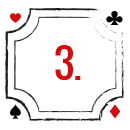 Many single-deck games in land-based casinos pay only 6 to 5, instead of 3 to 2, for a winning blackjack. When the casino pays only 6-5 for a blackjack, the house edge increases by 1.4% (ouch!). I’ll have more to say about these dastardly 6-5 games in Chapter 5 but for now remember to never play any blackjack game that pays 6-5 on a blackjack.
Many single-deck games in land-based casinos pay only 6 to 5, instead of 3 to 2, for a winning blackjack. When the casino pays only 6-5 for a blackjack, the house edge increases by 1.4% (ouch!). I’ll have more to say about these dastardly 6-5 games in Chapter 5 but for now remember to never play any blackjack game that pays 6-5 on a blackjack.
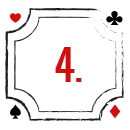 The house edge against a basic strategy player in a 3-2 single-deck game is a function of the mix of playing rules. The following table summarizes the relationship of typical rules that you will find in a 3-2 single-deck game and the corresponding house edge against a basic strategy player. You will be hard pressed to find a multiple-deck game with house edges as low as a single-deck, 3-2 game, with h27 and RSA (0.16%) or just h27 (0.19%).
The house edge against a basic strategy player in a 3-2 single-deck game is a function of the mix of playing rules. The following table summarizes the relationship of typical rules that you will find in a 3-2 single-deck game and the corresponding house edge against a basic strategy player. You will be hard pressed to find a multiple-deck game with house edges as low as a single-deck, 3-2 game, with h27 and RSA (0.16%) or just h27 (0.19%).
(Note: The house edges are from the respected book Blackjack Attack: Playing the Pros’ Way by Donald Schlesinger. The edges were computed for a basic strategy that considers just the total of all the cards in your hand (such as the basic strategy in the Tables and Charts in this chapter), without consideration of the individual cards that comprise that total. This basic strategy is known as Total-Dependent basic strategy. (I’ll have more to say about this in Chapter 6.)
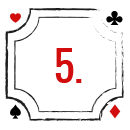 You can find which land-based casinos in the USA offer good 3-2 single-deck blackjack games (i.e., lowest house edge) in the monthly Current Blackjack News. This subscription-based newsletter is emailed to subscribers every month and lists the rules and house edge for blackjack games in casinos all over the U.S. and Canada.
You can find which land-based casinos in the USA offer good 3-2 single-deck blackjack games (i.e., lowest house edge) in the monthly Current Blackjack News. This subscription-based newsletter is emailed to subscribers every month and lists the rules and house edge for blackjack games in casinos all over the U.S. and Canada.
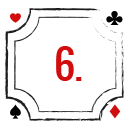 It’s rare for a casino nowadays to offer a single-deck game with S17 and DAS because a basic strategy player would have a tiny edge. Most single-deck games are h27 (or h27 with no doubling on soft hands). Surrender is rarely offered in a single-deck game (but I included it in the strategy charts and tables for the sake of completeness.)
It’s rare for a casino nowadays to offer a single-deck game with S17 and DAS because a basic strategy player would have a tiny edge. Most single-deck games are h27 (or h27 with no doubling on soft hands). Surrender is rarely offered in a single-deck game (but I included it in the strategy charts and tables for the sake of completeness.)
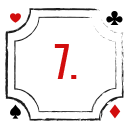 You can always find out if a local casino offers a 3-2 single-deck game by calling the main casino number, asking the operator to connect you with the blackjack pit, then asking the person that answers (usually the floor supervisor) if they offer a single-deck game, and what the rules and payoffs for a blackjack are. In most cases, they will provide you with the information.
You can always find out if a local casino offers a 3-2 single-deck game by calling the main casino number, asking the operator to connect you with the blackjack pit, then asking the person that answers (usually the floor supervisor) if they offer a single-deck game, and what the rules and payoffs for a blackjack are. In most cases, they will provide you with the information.
For each set of rules, you’ll find two different ways that the basic strategy is presented. The first is a black-and-white table and the second is a color-coded chart. Throughout the document I will refer to them as table and chart.
Note: The blackjack strategy charts lists the player’s two-card hand total and a possible multi-card hand total as a result of hitting a previously different hand one or more times. (In other words, play the multi-card hand as if it were an original two-card holding.)
For example, suppose you are dealt a 9-3 against a dealer’s 2 upcard in a six-deck game with Soft 17 and DAS. The strategy charts and tables state “hit.” You draw a 3 and you now have 15 against a dealer’s 2. If you look up the strategy for 15 against a 2 (table or chart), it states to “stand” against a dealer’s 2. And so you should stand.
For soft hands, since you can’t double down on more than two cards, any total that would have resulted in a double down, were it only two cards, now must become a hit or stand decision.
For example, suppose you are dealt an A-3 against a dealer’s 4 upcard. You hit (per the blackjack chart or table), and draw a 4. You now have A-3-4, which you should consider as A-7. If it were a two-card A-7, you would double down against a 4; however, since the A-7 is actually three cards, and you can’t double down, you stand.
Here’s another situation that could occur with pairs if the casino rules either don’t allow replits, or if they do, but you have split up to a maximum of four hands. For example, suppose you are dealt a pair of 6s, the dealer’s upcard is a 6, and the rules don’t allow replits. You split the 6s and on one 6 you draw another 6. Because you can’t resplit, you once again have to consider just the total of the hand (12) against the dealer’s 6 upcard and decide whether to stand or hit (for which, in this example, the blackjack strategy charts and tables state to stand). Suppose instead the casino rules allow replits and you draw two more 6s, giving you four hands, each one starting with a 6. On one (or more) of the 6s you draw yet another 6 (which could occur in a multi-deck game). Since you can’t split again, you must consider this hand as a 12 against a dealer’s 6 to determine how to play it.
Another point to keep in mind is that the strategy in the following tables and charts (also known as blackjack strategy card) does not consider the composition of the cards in the hand. For example, the strategy charts and tables state that you should hit hard 16 against a dealer’s 10 (assuming surrender is not offered), regardless if your 16 is composed of 10-6 or 8-4-4. (I’ll have more to say about composition-dependent strategy in Chapter 5.)
BLACKJACK STRATEGY CHARTS
The color-coded strategy chart contains the same information as the black-and-white table except it presents the strategy in the form of a color-coded strategy chart matrix. (The reason is that some players find it easier to learn the basic strategy with a blackjack strategy chart.) The dealer’s upcard (2 though Ace) appears along the top of the chart and the player’s hand can be found down the first column (grouped in order by Hard Hands, Soft Hands, followed by Pairs). For example, if you are dealt, say, a 12 and the dealer’s upcard is a 2, go down the first column to 12, go across the top (Dealers’ Upcard ) to the 2, and at the intersection of the 12 and the 2 is the letter H, meaning the correct strategy is to hit.
Let’s try another hand. Supposed you are playing a single-deck, h27, NDAS game and you are dealt an A-7 against the dealer’s upcard of 6. To find the correct strategy, go down the first column to A-7 and then go across the row until it intersects with the column labeled 6 (i.e., dealer’s upcard). You’ll notice the letters Ds at that intersection. The abbreviation Ds means double down if the rules allow it, otherwise, you should stand.
(Note: There is a listing of abbreviations at the bottom of each chart or strategy card)
ONE FINAL TIP:
notice that the charts are color coded. The background colors for each decision are:
 The color-coded strategy chart contains the same information as the black-and-white table except it presents the strategy in the form of a color-coded strategy chart matrix. (The reason is that some players find it easier to learn the basic strategy with a blackjack strategy chart.) The dealer’s upcard (2 though Ace) appears along the top of the chart and the player’s hand can be found down the first column (grouped in order by Hard Hands, Soft Hands, followed by Pairs). For example, if you are dealt, say, a 12 and the dealer’s upcard is a 2, go down the first column to 12, go across the top (Dealers’ Upcard ) to the 2, and at the intersection of the 12 and the 2 is the letter H, meaning the correct strategy is to hit.
The color-coded strategy chart contains the same information as the black-and-white table except it presents the strategy in the form of a color-coded strategy chart matrix. (The reason is that some players find it easier to learn the basic strategy with a blackjack strategy chart.) The dealer’s upcard (2 though Ace) appears along the top of the chart and the player’s hand can be found down the first column (grouped in order by Hard Hands, Soft Hands, followed by Pairs). For example, if you are dealt, say, a 12 and the dealer’s upcard is a 2, go down the first column to 12, go across the top (Dealers’ Upcard ) to the 2, and at the intersection of the 12 and the 2 is the letter H, meaning the correct strategy is to hit.
Let’s try another hand. Supposed you are playing a single-deck, h27, NDAS game and you are dealt an A-7 against the dealer’s upcard of 6. To find the correct strategy, go down the first column to A-7 and then go across the row until it intersects with the column labeled 6 (i.e., dealer’s upcard). You’ll notice the letters Ds at that intersection. The abbreviation Ds means double down if the rules allow it, otherwise, you should stand.
(Note: There is a listing of abbreviations at the bottom of each chart or strategy card)
notice that the charts are color coded. The background colors for each decision are:


SINGLE DECK BLACKJACK, S17, DAS TABLE

SINGLE DECK BLACKJACK, S17, DAS CHART



SINGLE DECK BLACKJACK, S17, NDAS TABLE

SINGLE DECK BLACKJACK, S17, NDAS CHART



SINGLE DECK BLACKJACK, h27, DAS TABLE

SINGLE DECK BLACKJACK, h27, DAS CHART



SINGLE DECK BLACKJACK, h27, NDAS TABLE

SINGLE DECK BLACKJACK, h27, NDAS CHART



INSIDER TIPS FOR PLAYING SINGLE-DECK GAMES
 In most single-deck games, the dealers pitch the cards face down to players and a discard tray is not used (although a few casinos have used them). It’s rare when a casino will deal the cards face up to players in a single-deck game. Be sure you know the correct etiquette for holding your cards and signaling your playing decision to the dealer when playing in a single-deck game. (See Chapter 1.3.)
In most single-deck games, the dealers pitch the cards face down to players and a discard tray is not used (although a few casinos have used them). It’s rare when a casino will deal the cards face up to players in a single-deck game. Be sure you know the correct etiquette for holding your cards and signaling your playing decision to the dealer when playing in a single-deck game. (See Chapter 1.3.)
 The basic strategy for pair splitting changes slightly when the rules specify NDAS vs. DAS. If you look at the pair splitting strategy in the strategy charts for NDAS vs. DAS you’ll see that you will split more times when the rules specify DAS vs. NDAS. That’s because you want to be more aggressive in splitting when you have the opportunity to double down after you split. For example, with NDAS, you split 3s against a dealer’s 4, 5, and 6 upcard but with DAS, you extend the pair splitting to include the dealer’s 2 and 3 upcards.
The basic strategy for pair splitting changes slightly when the rules specify NDAS vs. DAS. If you look at the pair splitting strategy in the strategy charts for NDAS vs. DAS you’ll see that you will split more times when the rules specify DAS vs. NDAS. That’s because you want to be more aggressive in splitting when you have the opportunity to double down after you split. For example, with NDAS, you split 3s against a dealer’s 4, 5, and 6 upcard but with DAS, you extend the pair splitting to include the dealer’s 2 and 3 upcards.
 Many single-deck games in land-based casinos pay only 6 to 5, instead of 3 to 2, for a winning blackjack. When the casino pays only 6-5 for a blackjack, the house edge increases by 1.4% (ouch!). I’ll have more to say about these dastardly 6-5 games in Chapter 5 but for now remember to never play any blackjack game that pays 6-5 on a blackjack.
Many single-deck games in land-based casinos pay only 6 to 5, instead of 3 to 2, for a winning blackjack. When the casino pays only 6-5 for a blackjack, the house edge increases by 1.4% (ouch!). I’ll have more to say about these dastardly 6-5 games in Chapter 5 but for now remember to never play any blackjack game that pays 6-5 on a blackjack.
 The house edge against a basic strategy player in a 3-2 single-deck game is a function of the mix of playing rules. The following table summarizes the relationship of typical rules that you will find in a 3-2 single-deck game and the corresponding house edge against a basic strategy player. You will be hard pressed to find a multiple-deck game with house edges as low as a single-deck, 3-2 game, with h27 and RSA (0.16%) or just h27 (0.19%).
The house edge against a basic strategy player in a 3-2 single-deck game is a function of the mix of playing rules. The following table summarizes the relationship of typical rules that you will find in a 3-2 single-deck game and the corresponding house edge against a basic strategy player. You will be hard pressed to find a multiple-deck game with house edges as low as a single-deck, 3-2 game, with h27 and RSA (0.16%) or just h27 (0.19%).
(Note: The house edges are from the respected book Blackjack Attack: Playing the Pros’ Way by Donald Schlesinger. The edges were computed for a basic strategy that considers just the total of all the cards in your hand (such as the basic strategy in the Tables and Charts in this chapter), without consideration of the individual cards that comprise that total. This basic strategy is known as Total-Dependent basic strategy. (I’ll have more to say about this in Chapter 6.)
 You can find which land-based casinos in the USA offer good 3-2 single-deck blackjack games (i.e., lowest house edge) in the monthly Current Blackjack News. This subscription-based newsletter is emailed to subscribers every month and lists the rules and house edge for blackjack games in casinos all over the U.S. and Canada.
You can find which land-based casinos in the USA offer good 3-2 single-deck blackjack games (i.e., lowest house edge) in the monthly Current Blackjack News. This subscription-based newsletter is emailed to subscribers every month and lists the rules and house edge for blackjack games in casinos all over the U.S. and Canada.
 It’s rare for a casino nowadays to offer a single-deck game with S17 and DAS because a basic strategy player would have a tiny edge. Most single-deck games are h27 (or h27 with no doubling on soft hands). Surrender is rarely offered in a single-deck game (but I included it in the strategy charts and tables for the sake of completeness.)
It’s rare for a casino nowadays to offer a single-deck game with S17 and DAS because a basic strategy player would have a tiny edge. Most single-deck games are h27 (or h27 with no doubling on soft hands). Surrender is rarely offered in a single-deck game (but I included it in the strategy charts and tables for the sake of completeness.)
 You can always find out if a local casino offers a 3-2 single-deck game by calling the main casino number, asking the operator to connect you with the blackjack pit, then asking the person that answers (usually the floor supervisor) if they offer a single-deck game, and what the rules and payoffs for a blackjack are. In most cases, they will provide you with the information.
You can always find out if a local casino offers a 3-2 single-deck game by calling the main casino number, asking the operator to connect you with the blackjack pit, then asking the person that answers (usually the floor supervisor) if they offer a single-deck game, and what the rules and payoffs for a blackjack are. In most cases, they will provide you with the information.
DOUBLE-DECK BLACKJACK GAME
The same abbreviations that were used in the blackjack strategy charts for single-deck games are used for double-deck games.
Note: The abbreviations also appear below each table and strategy chart.
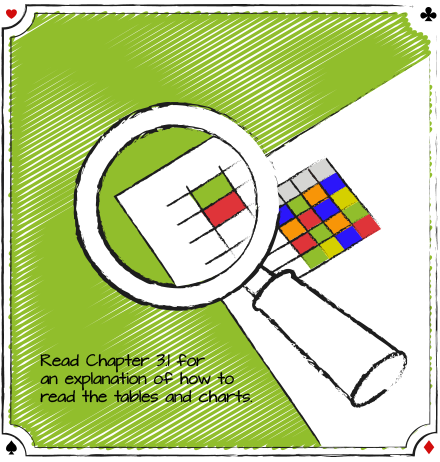
HOW TO USE THE BLACKJACK STRATEGY CHARTS AND TABLES
Below are some sample hands for a double-deck game.
Suppose you are playing a S17, DAS game and you are dealt A-7 and the dealer shows a 9 upcard. If you refer to the Double-Deck, S17, DAS Table, you will find the following rule for A-7:
* Double on 3 through 6 ** Stand on 2, 7, 8; Hit on 9, 10, A
Since the dealer’s upcard is a 9, the correct basic strategy play is to Hit.
If you refer to the Double Deck, Soft 17, DAS chart, you will see that at the intersection of the A-7 and dealer’s 9 upcard is the letter H, meaning Hit.
Let’s try one more hand. You are dealt 4-4 and the dealer’s upcard is a 5. The rules are Hard 17, DAS. What does the strategy table or chart say to play it?
The answer is to Split.
BLACKJACK STRATEGY CHARTS AND TABLES
DOUBLE DECK BLACKJACK, S17, DAS
BLACKJACK STRATEGY TABLE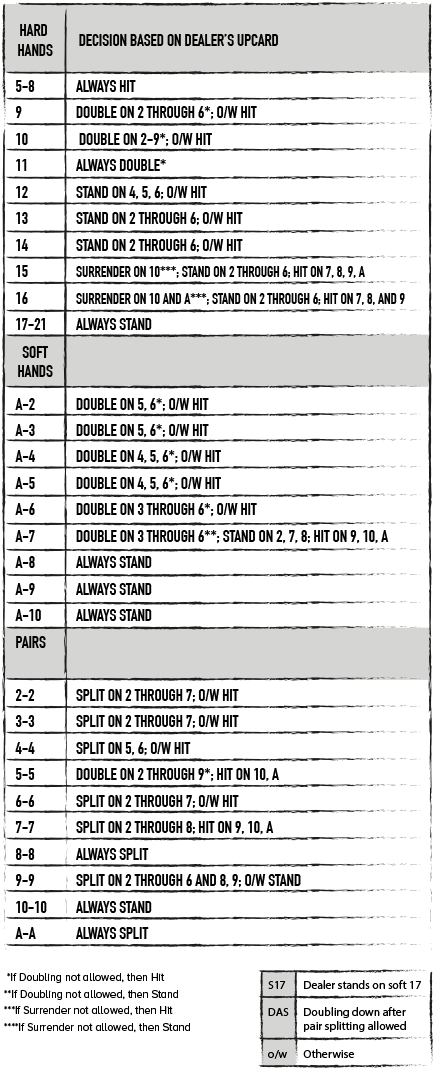
DOUBLE DECK BLACKJACK, S17, DAS
BLACKJACK STRATEGY CHART
DOUBLE DECK BLACKJACK, S17, NDAS
BLACKJACK STRATEGY TABLE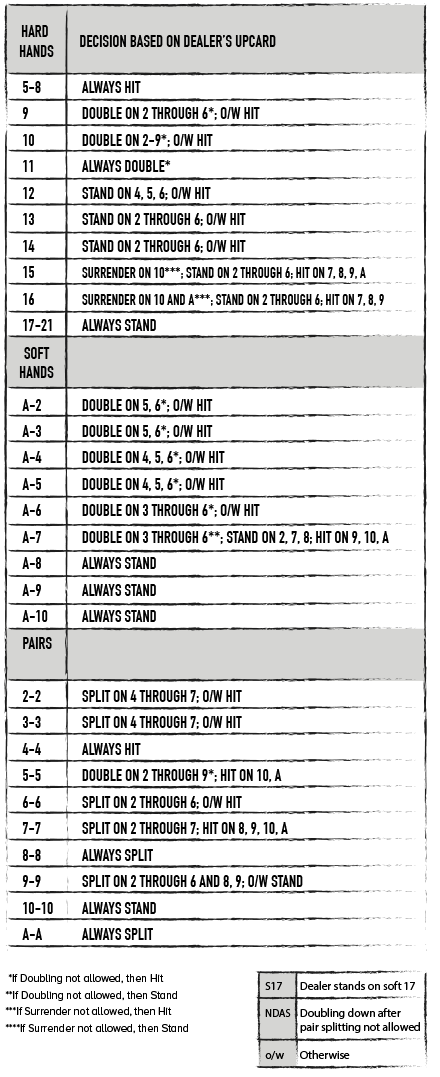
DOUBLE DECK BLACKJACK, S17, NDAS
BLACKJACK STRATEGY CHART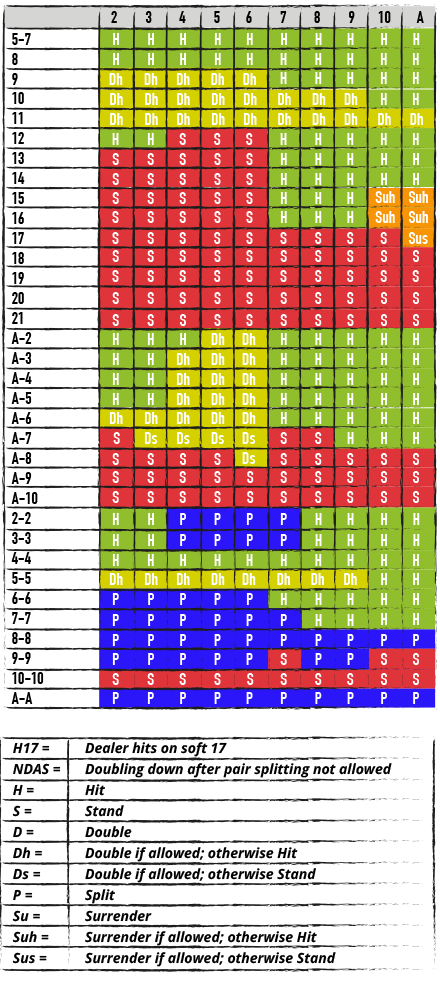
DOUBLE DECK BLACKJACK, h27, DAS
BLACKJACK STRATEGY TABLE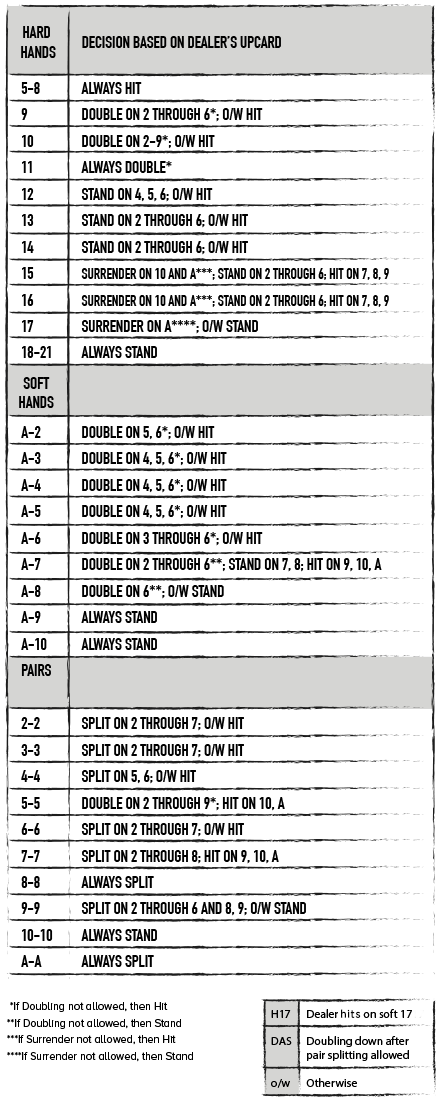
DOUBLE DECK BLACKJACK, h27, DAS
BLACKJACK STRATEGY CHART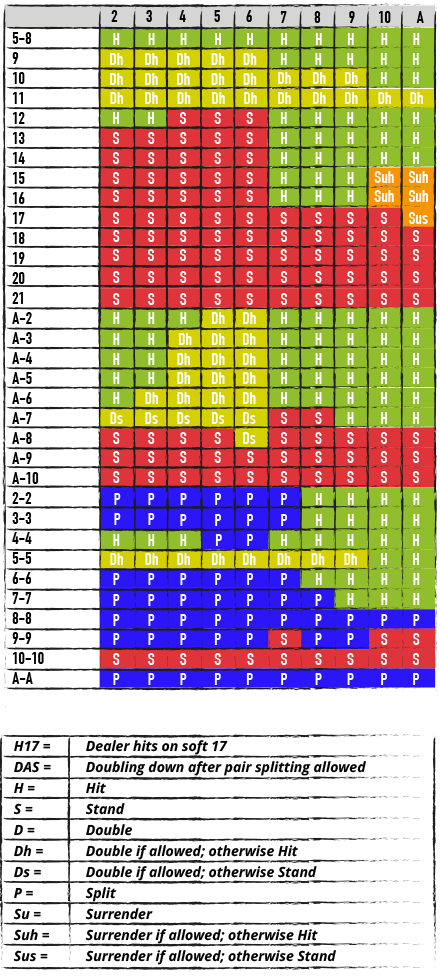
DOUBLE DECK BLACKJACK, h27, NDAS
BLACKJACK STRATEGY TABLE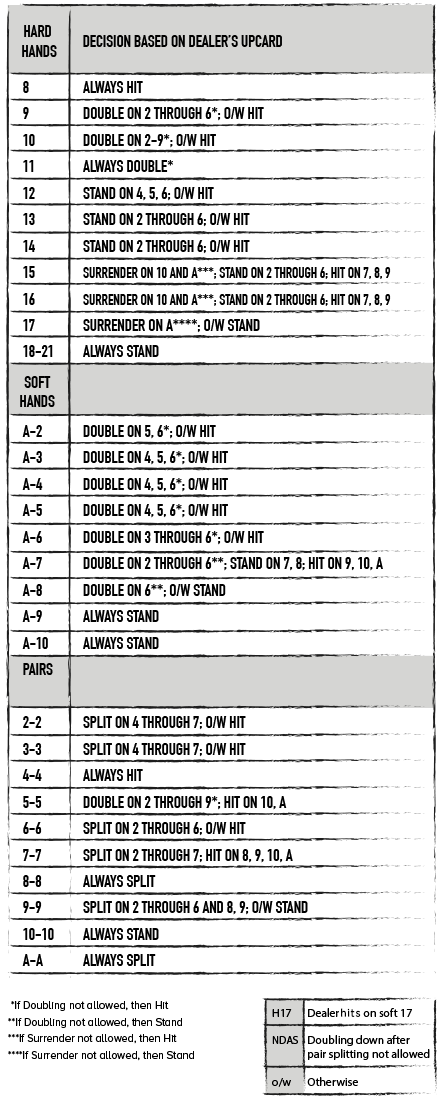
DOUBLE DECK BLACKJACK, h27, NDAS
BLACKJACK STRATEGY CHART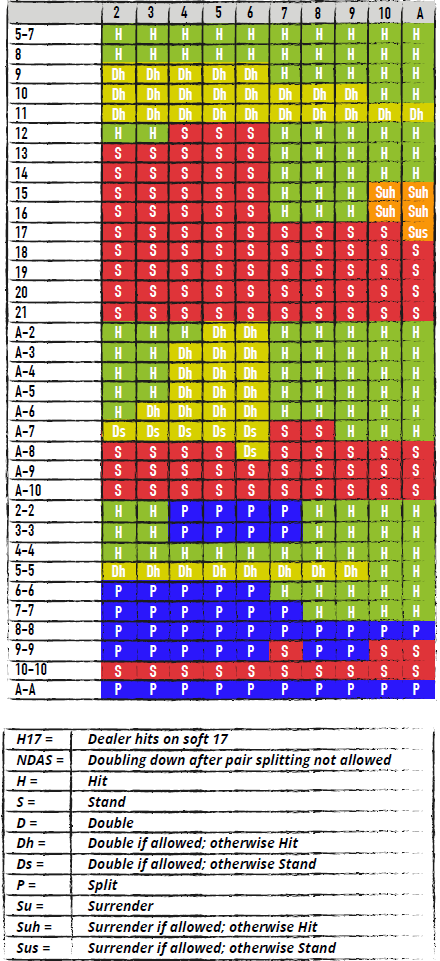
INSIDER TIPS FOR PLAYING DOUBLE-DECK GAMES
 In most double-deck games, the dealers pitch the cards face down to players, although a few casinos use a dealing shoe, but that’s rare. Be sure you know the correct Blackjack etiquette for holding your cards and signaling your playing decision to the dealer when playing in a double-deck pitch game.
In most double-deck games, the dealers pitch the cards face down to players, although a few casinos use a dealing shoe, but that’s rare. Be sure you know the correct Blackjack etiquette for holding your cards and signaling your playing decision to the dealer when playing in a double-deck pitch game.
 Some double-deck games in land-based casinos pay only 6 to 5, instead of 3 to 2, for a winning blackjack. When the casino pays only 6-5 for a blackjack, the house edge increases by 1.4% (ouch!). I’ll have more to say about these dastardly 6-5 games in Chapter 6.2 but for now remember to never play any blackjack game that pays 6-5 on a blackjack.
Some double-deck games in land-based casinos pay only 6 to 5, instead of 3 to 2, for a winning blackjack. When the casino pays only 6-5 for a blackjack, the house edge increases by 1.4% (ouch!). I’ll have more to say about these dastardly 6-5 games in Chapter 6.2 but for now remember to never play any blackjack game that pays 6-5 on a blackjack.

 The house edge against a basic strategy player in a 3-2 double-deck game is a function of the mix of playing rules. The following table summarizes the relationship of typical rules that you will find in a 3-2 double-deck game and the corresponding house edge against a basic strategy player. Notice that the best double-deck games offer S17 and DAS (with or without RSA). The house edge is only 0.14% - 0.19%, which is quite good. If your local casino offers only an h27 double-deck game, make sure they allow DAS, and better yet, with RSA and/or LS. Note: The house edges are from the respected book Blackjack Attack: Playing the Pros’ Way by Donald Schlesinger. The edges were computed for a basic strategy that considers just the total of all the cards in your hand, such as the basic strategy in the Tables and Charts in this chapter, without consideration of the individual cards that comprise that total. This basic strategy is known as total-dependent basic strategy. (I’ll have more to say about this in Chapter 5.)
The house edge against a basic strategy player in a 3-2 double-deck game is a function of the mix of playing rules. The following table summarizes the relationship of typical rules that you will find in a 3-2 double-deck game and the corresponding house edge against a basic strategy player. Notice that the best double-deck games offer S17 and DAS (with or without RSA). The house edge is only 0.14% - 0.19%, which is quite good. If your local casino offers only an h27 double-deck game, make sure they allow DAS, and better yet, with RSA and/or LS. Note: The house edges are from the respected book Blackjack Attack: Playing the Pros’ Way by Donald Schlesinger. The edges were computed for a basic strategy that considers just the total of all the cards in your hand, such as the basic strategy in the Tables and Charts in this chapter, without consideration of the individual cards that comprise that total. This basic strategy is known as total-dependent basic strategy. (I’ll have more to say about this in Chapter 5.)
 You can find which land-based casinos in the USA offer good 3-2 single-deck blackjack games; i.e., lowest house edge in the monthly Current Blackjack News. This subscription-based newsletter is emailed to subscribers every month and lists the rules and house edge for blackjack games in casinos all over the U.S. and Canada.
You can find which land-based casinos in the USA offer good 3-2 single-deck blackjack games; i.e., lowest house edge in the monthly Current Blackjack News. This subscription-based newsletter is emailed to subscribers every month and lists the rules and house edge for blackjack games in casinos all over the U.S. and Canada.
 You can always find out if a local casino offers a 3-2 double-deck game by calling the main casino number, asking the operator to connect you with the blackjack pit, then asking the person that answers usually the floor supervisor if they offer a double-deck game, and what the rules and payoffs for a blackjack are. In most cases, they will provide you with the information.
You can always find out if a local casino offers a 3-2 double-deck game by calling the main casino number, asking the operator to connect you with the blackjack pit, then asking the person that answers usually the floor supervisor if they offer a double-deck game, and what the rules and payoffs for a blackjack are. In most cases, they will provide you with the information.
Below are some sample hands for a double-deck game.
Suppose you are playing a S17, DAS game and you are dealt A-7 and the dealer shows a 9 upcard. If you refer to the Double-Deck, S17, DAS Table, you will find the following rule for A-7:
* Double on 3 through 6 ** Stand on 2, 7, 8; Hit on 9, 10, A
Since the dealer’s upcard is a 9, the correct basic strategy play is to Hit.
If you refer to the Double Deck, Soft 17, DAS chart, you will see that at the intersection of the A-7 and dealer’s 9 upcard is the letter H, meaning Hit.
Let’s try one more hand. You are dealt 4-4 and the dealer’s upcard is a 5. The rules are Hard 17, DAS. What does the strategy table or chart say to play it?
The answer is to Split.
BLACKJACK STRATEGY CHARTS AND TABLES
DOUBLE DECK BLACKJACK, S17, DAS
BLACKJACK STRATEGY TABLE
DOUBLE DECK BLACKJACK, S17, DAS
BLACKJACK STRATEGY CHARTBLACKJACK STRATEGY TABLE BLACKJACK STRATEGY CHART
BLACKJACK STRATEGY CHART
DOUBLE DECK BLACKJACK, S17, NDAS
BLACKJACK STRATEGY TABLE
DOUBLE DECK BLACKJACK, S17, NDAS
BLACKJACK STRATEGY CHART BLACKJACK STRATEGY TABLE
BLACKJACK STRATEGY TABLE BLACKJACK STRATEGY CHART
BLACKJACK STRATEGY CHART
DOUBLE DECK BLACKJACK, h27, DAS
BLACKJACK STRATEGY TABLE
DOUBLE DECK BLACKJACK, h27, DAS
BLACKJACK STRATEGY CHART BLACKJACK STRATEGY TABLE
BLACKJACK STRATEGY TABLE BLACKJACK STRATEGY CHART
BLACKJACK STRATEGY CHART
DOUBLE DECK BLACKJACK, h27, NDAS
BLACKJACK STRATEGY TABLE
DOUBLE DECK BLACKJACK, h27, NDAS
BLACKJACK STRATEGY CHART BLACKJACK STRATEGY TABLE
BLACKJACK STRATEGY TABLE BLACKJACK STRATEGY CHART
BLACKJACK STRATEGY CHART
INSIDER TIPS FOR PLAYING DOUBLE-DECK GAMES
 In most double-deck games, the dealers pitch the cards face down to players, although a few casinos use a dealing shoe, but that’s rare. Be sure you know the correct Blackjack etiquette for holding your cards and signaling your playing decision to the dealer when playing in a double-deck pitch game.
In most double-deck games, the dealers pitch the cards face down to players, although a few casinos use a dealing shoe, but that’s rare. Be sure you know the correct Blackjack etiquette for holding your cards and signaling your playing decision to the dealer when playing in a double-deck pitch game.
 Some double-deck games in land-based casinos pay only 6 to 5, instead of 3 to 2, for a winning blackjack. When the casino pays only 6-5 for a blackjack, the house edge increases by 1.4% (ouch!). I’ll have more to say about these dastardly 6-5 games in Chapter 6.2 but for now remember to never play any blackjack game that pays 6-5 on a blackjack.
Some double-deck games in land-based casinos pay only 6 to 5, instead of 3 to 2, for a winning blackjack. When the casino pays only 6-5 for a blackjack, the house edge increases by 1.4% (ouch!). I’ll have more to say about these dastardly 6-5 games in Chapter 6.2 but for now remember to never play any blackjack game that pays 6-5 on a blackjack.

 The house edge against a basic strategy player in a 3-2 double-deck game is a function of the mix of playing rules. The following table summarizes the relationship of typical rules that you will find in a 3-2 double-deck game and the corresponding house edge against a basic strategy player. Notice that the best double-deck games offer S17 and DAS (with or without RSA). The house edge is only 0.14% - 0.19%, which is quite good. If your local casino offers only an h27 double-deck game, make sure they allow DAS, and better yet, with RSA and/or LS. Note: The house edges are from the respected book Blackjack Attack: Playing the Pros’ Way by Donald Schlesinger. The edges were computed for a basic strategy that considers just the total of all the cards in your hand, such as the basic strategy in the Tables and Charts in this chapter, without consideration of the individual cards that comprise that total. This basic strategy is known as total-dependent basic strategy. (I’ll have more to say about this in Chapter 5.)
The house edge against a basic strategy player in a 3-2 double-deck game is a function of the mix of playing rules. The following table summarizes the relationship of typical rules that you will find in a 3-2 double-deck game and the corresponding house edge against a basic strategy player. Notice that the best double-deck games offer S17 and DAS (with or without RSA). The house edge is only 0.14% - 0.19%, which is quite good. If your local casino offers only an h27 double-deck game, make sure they allow DAS, and better yet, with RSA and/or LS. Note: The house edges are from the respected book Blackjack Attack: Playing the Pros’ Way by Donald Schlesinger. The edges were computed for a basic strategy that considers just the total of all the cards in your hand, such as the basic strategy in the Tables and Charts in this chapter, without consideration of the individual cards that comprise that total. This basic strategy is known as total-dependent basic strategy. (I’ll have more to say about this in Chapter 5.)
 You can find which land-based casinos in the USA offer good 3-2 single-deck blackjack games; i.e., lowest house edge in the monthly Current Blackjack News. This subscription-based newsletter is emailed to subscribers every month and lists the rules and house edge for blackjack games in casinos all over the U.S. and Canada.
You can find which land-based casinos in the USA offer good 3-2 single-deck blackjack games; i.e., lowest house edge in the monthly Current Blackjack News. This subscription-based newsletter is emailed to subscribers every month and lists the rules and house edge for blackjack games in casinos all over the U.S. and Canada.
 You can always find out if a local casino offers a 3-2 double-deck game by calling the main casino number, asking the operator to connect you with the blackjack pit, then asking the person that answers usually the floor supervisor if they offer a double-deck game, and what the rules and payoffs for a blackjack are. In most cases, they will provide you with the information.
You can always find out if a local casino offers a 3-2 double-deck game by calling the main casino number, asking the operator to connect you with the blackjack pit, then asking the person that answers usually the floor supervisor if they offer a double-deck game, and what the rules and payoffs for a blackjack are. In most cases, they will provide you with the information.
FOUR OR MORE DECKS BLACKJACK GAME
The same abbreviations that were used in the tables and charts for single- and double-deck games are used for four or more decks. Note: The abbreviations also appear below each blackjack strategy chart.
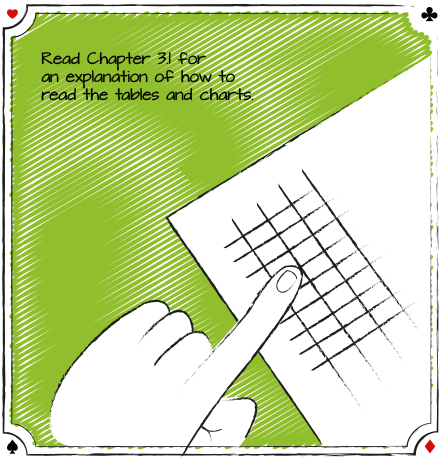
HOW TO USE THE BLACKJACK STRATEGY CHARTS AND TABLES
Suppose you are playing a S17, DAS game and you are dealt 10-6 and the dealer shows a 10 upcard. If you refer to the Four-or-More Decks, S17, DAS Table, you will find the following rule for hard 16:
* Surrender on 9, 10, A***; Stand on 2 through 6; Hit on 7 and 8
Since the dealer’s upcard is a 10, the correct basic strategy play is to Surrender. If the casino rules for surrender don’t allow you to do so, then you should hit. When you check the *** at the bottom of the table, it explains what to do if surrender is not offered.
If you refer to the Four-or-More Decks, Soft 17, DAS chart, you will see that at the intersection of the 16 and dealer’s 10 upcard, the box states “Suh.” This means surrender if allowed; otherwise, hit.
Let’s try one more hand. You are dealt 7-7 and the dealer’s upcard is a 7. The rules are Hard 17, DAS. How does the strategy chart or blackjack strategy card say to play it?
The answer is to Split.
BLACKJACK STRATEGY CHARTS AND TABLES
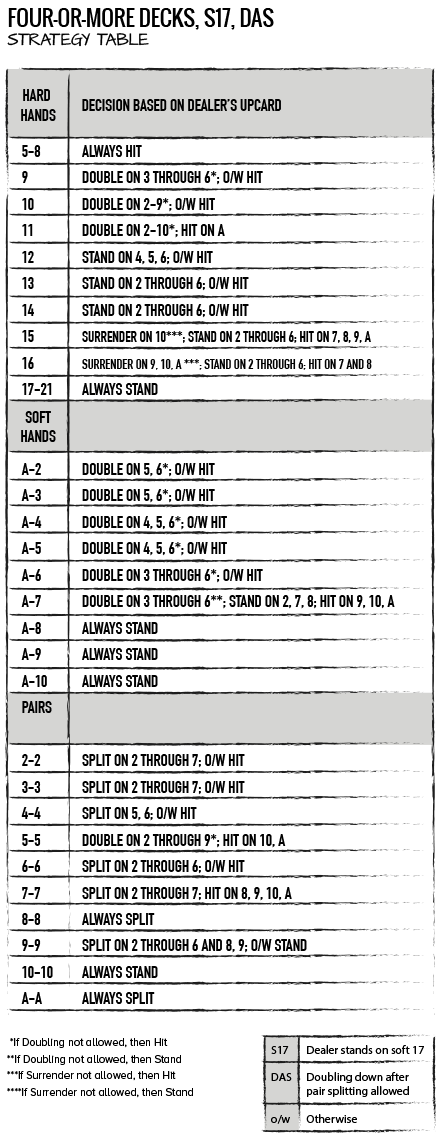
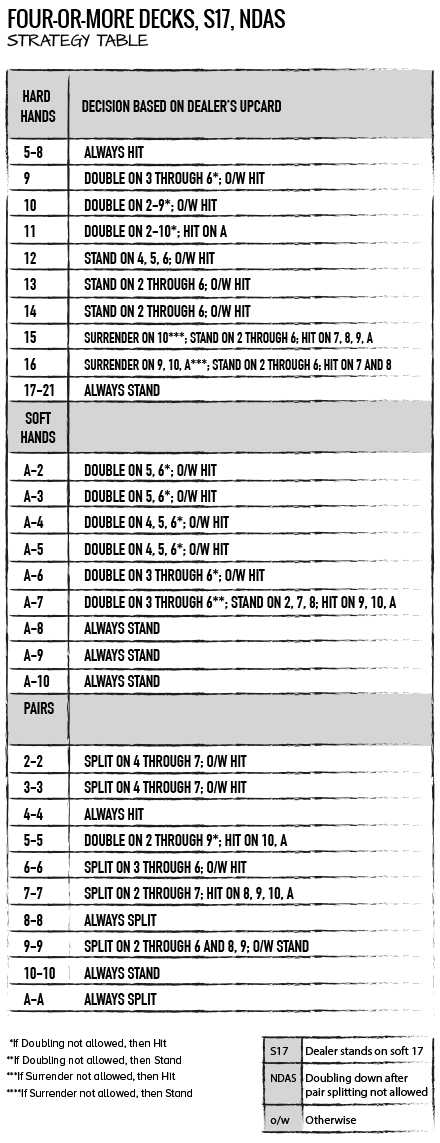
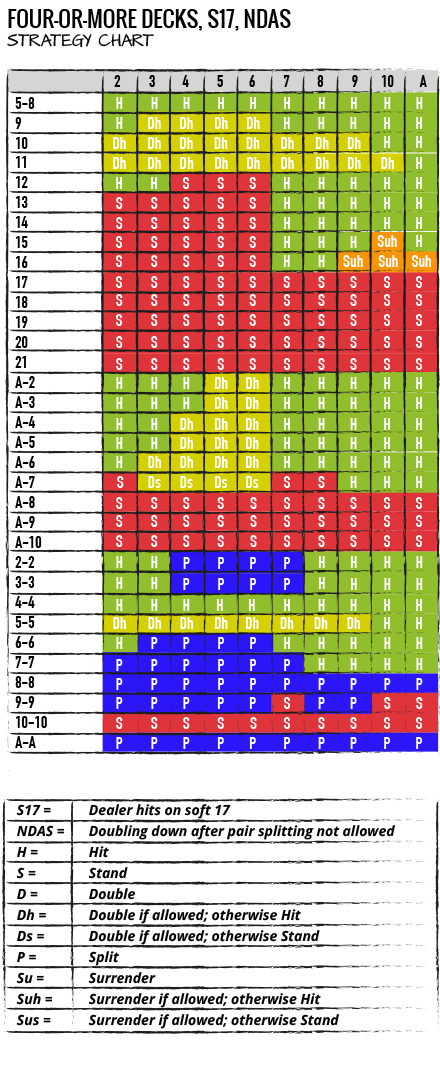
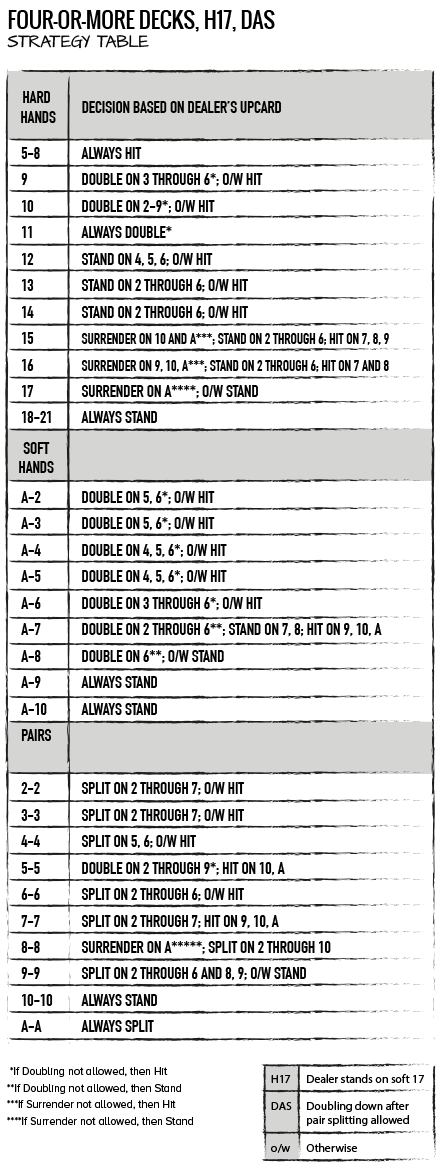
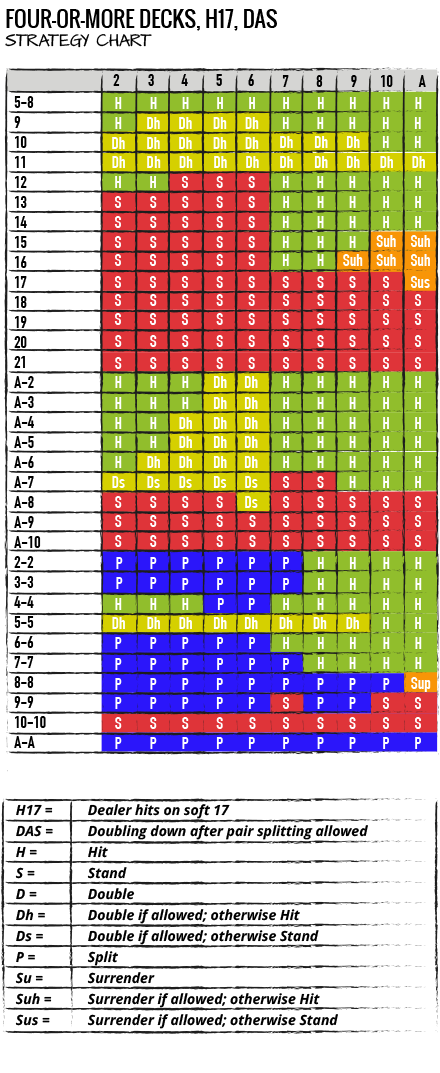
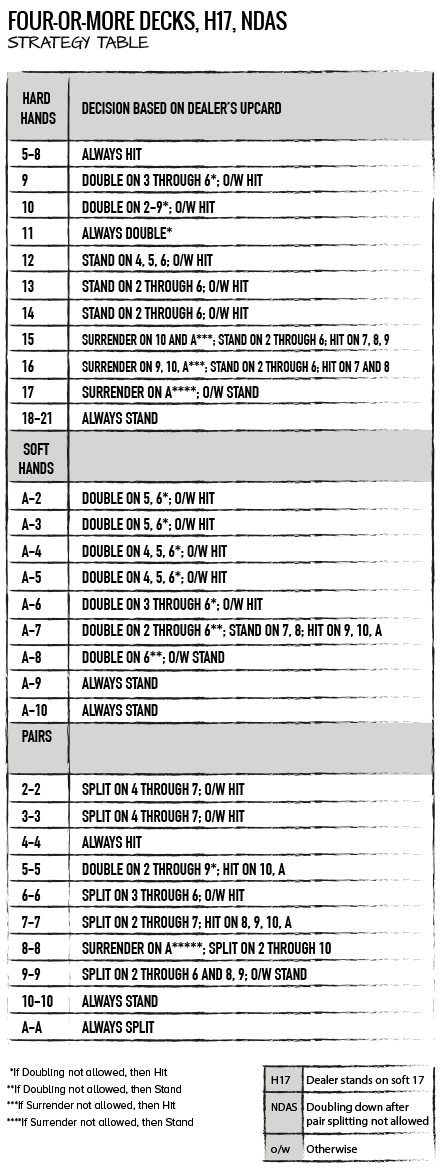
INSIDER TIPS FOR PLAYING FOUR OR MORE DECKS
 The cards are dealt face up from a dealing shoe. Be sure you know the correct playing etiquette and how to signal your playing decision to the dealer when the cards are dealt face up.
The cards are dealt face up from a dealing shoe. Be sure you know the correct playing etiquette and how to signal your playing decision to the dealer when the cards are dealt face up.
 Most shoe-dealt games in land-based casinos use six-decks of cards. Next most common is an eight-deck game; the four-deck game, once quite popular, is now rather rare.
Most shoe-dealt games in land-based casinos use six-decks of cards. Next most common is an eight-deck game; the four-deck game, once quite popular, is now rather rare.
 Some games dealt with four or more decks in land-based casinos pay only 6 to 5, instead of 3 to 2, for a winning blackjack. When the casino pays only 6-5 for a blackjack, the house edge increases by 1.4% (ouch!). I’ll have more to say about these dastardly 6-5 games in Chapter 6 but for now remember to never play any blackjack game that pays 6-5 on a blackjack.
Some games dealt with four or more decks in land-based casinos pay only 6 to 5, instead of 3 to 2, for a winning blackjack. When the casino pays only 6-5 for a blackjack, the house edge increases by 1.4% (ouch!). I’ll have more to say about these dastardly 6-5 games in Chapter 6 but for now remember to never play any blackjack game that pays 6-5 on a blackjack.
 The house edge against a basic strategy player in a 3-2 four-, six-, or eight-deck game is a function of the mix of playing rules. The following table summarizes the relationship of typical rules that you will find and the corresponding house edge against a basic strategy player.
The house edge against a basic strategy player in a 3-2 four-, six-, or eight-deck game is a function of the mix of playing rules. The following table summarizes the relationship of typical rules that you will find and the corresponding house edge against a basic strategy player.
As a general rule, the best six-deck game has S17, DAS, RSA, and LS (house edge 0.26%). If the casino offers S17, DAS, and either RSA or LS, but not both, the house edge is still respectable (0.34% and 0.33% respectively). The house edge will increase if the rules are h27. If you must play a six-deck, h27 game, be sure the rules allow at least DAS, LS, and RSA (0.46%) or h27, DAS, and either LS (0.53%) or RSA (0.55%). For eight-deck games, you want, at a minimum, S17, DAS, and LS (0.36%). If the game is h27, you want at least DAS and RSA (0.58%). Note: The house edges are from the respected book Blackjack Attack: Playing the Pros’ Way by Donald Schlesinger. The edges were computed for a basic strategy that considers just the total of all the cards in your hand such as the basic strategy Charts and tables (also known as blackjack strategy card) in this chapter, without consideration of the individual cards that comprise that total. This basic strategy is known as total-dependent basic strategy. I’ll have more to say about this in Chapter 5.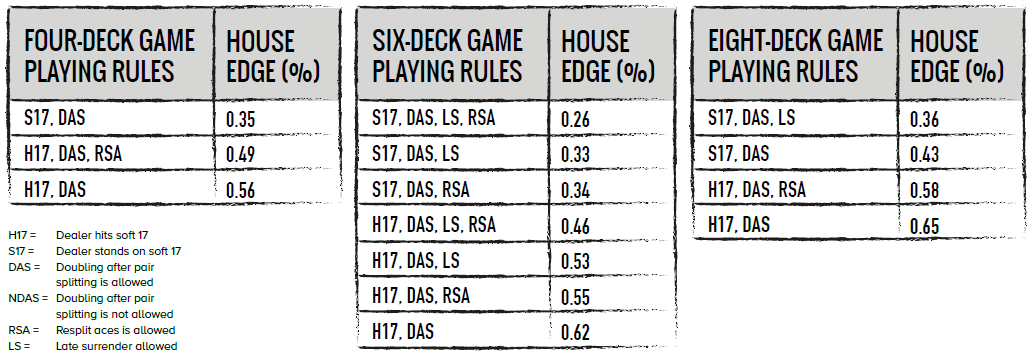
 You can find which land-based casinos in the USA offer good 3-2 four-, six-, and eight-deck blackjack games, i.e., lowest house edge, in the monthly Current Blackjack News. This subscription-based newsletter is emailed to subscribers every month and lists the rules and house edge for blackjack games in casinos all over the U.S. and Canada.
You can find which land-based casinos in the USA offer good 3-2 four-, six-, and eight-deck blackjack games, i.e., lowest house edge, in the monthly Current Blackjack News. This subscription-based newsletter is emailed to subscribers every month and lists the rules and house edge for blackjack games in casinos all over the U.S. and Canada.
Suppose you are playing a S17, DAS game and you are dealt 10-6 and the dealer shows a 10 upcard. If you refer to the Four-or-More Decks, S17, DAS Table, you will find the following rule for hard 16:
* Surrender on 9, 10, A***; Stand on 2 through 6; Hit on 7 and 8
Since the dealer’s upcard is a 10, the correct basic strategy play is to Surrender. If the casino rules for surrender don’t allow you to do so, then you should hit. When you check the *** at the bottom of the table, it explains what to do if surrender is not offered.
If you refer to the Four-or-More Decks, Soft 17, DAS chart, you will see that at the intersection of the 16 and dealer’s 10 upcard, the box states “Suh.” This means surrender if allowed; otherwise, hit.
Let’s try one more hand. You are dealt 7-7 and the dealer’s upcard is a 7. The rules are Hard 17, DAS. How does the strategy chart or blackjack strategy card say to play it?
The answer is to Split.
BLACKJACK STRATEGY CHARTS AND TABLES






INSIDER TIPS FOR PLAYING FOUR OR MORE DECKS
 The cards are dealt face up from a dealing shoe. Be sure you know the correct playing etiquette and how to signal your playing decision to the dealer when the cards are dealt face up.
The cards are dealt face up from a dealing shoe. Be sure you know the correct playing etiquette and how to signal your playing decision to the dealer when the cards are dealt face up.
 Most shoe-dealt games in land-based casinos use six-decks of cards. Next most common is an eight-deck game; the four-deck game, once quite popular, is now rather rare.
Most shoe-dealt games in land-based casinos use six-decks of cards. Next most common is an eight-deck game; the four-deck game, once quite popular, is now rather rare.
 Some games dealt with four or more decks in land-based casinos pay only 6 to 5, instead of 3 to 2, for a winning blackjack. When the casino pays only 6-5 for a blackjack, the house edge increases by 1.4% (ouch!). I’ll have more to say about these dastardly 6-5 games in Chapter 6 but for now remember to never play any blackjack game that pays 6-5 on a blackjack.
Some games dealt with four or more decks in land-based casinos pay only 6 to 5, instead of 3 to 2, for a winning blackjack. When the casino pays only 6-5 for a blackjack, the house edge increases by 1.4% (ouch!). I’ll have more to say about these dastardly 6-5 games in Chapter 6 but for now remember to never play any blackjack game that pays 6-5 on a blackjack.
 The house edge against a basic strategy player in a 3-2 four-, six-, or eight-deck game is a function of the mix of playing rules. The following table summarizes the relationship of typical rules that you will find and the corresponding house edge against a basic strategy player.
The house edge against a basic strategy player in a 3-2 four-, six-, or eight-deck game is a function of the mix of playing rules. The following table summarizes the relationship of typical rules that you will find and the corresponding house edge against a basic strategy player.
As a general rule, the best six-deck game has S17, DAS, RSA, and LS (house edge 0.26%). If the casino offers S17, DAS, and either RSA or LS, but not both, the house edge is still respectable (0.34% and 0.33% respectively). The house edge will increase if the rules are h27. If you must play a six-deck, h27 game, be sure the rules allow at least DAS, LS, and RSA (0.46%) or h27, DAS, and either LS (0.53%) or RSA (0.55%). For eight-deck games, you want, at a minimum, S17, DAS, and LS (0.36%). If the game is h27, you want at least DAS and RSA (0.58%). Note: The house edges are from the respected book Blackjack Attack: Playing the Pros’ Way by Donald Schlesinger. The edges were computed for a basic strategy that considers just the total of all the cards in your hand such as the basic strategy Charts and tables (also known as blackjack strategy card) in this chapter, without consideration of the individual cards that comprise that total. This basic strategy is known as total-dependent basic strategy. I’ll have more to say about this in Chapter 5.
 You can find which land-based casinos in the USA offer good 3-2 four-, six-, and eight-deck blackjack games, i.e., lowest house edge, in the monthly Current Blackjack News. This subscription-based newsletter is emailed to subscribers every month and lists the rules and house edge for blackjack games in casinos all over the U.S. and Canada.
You can find which land-based casinos in the USA offer good 3-2 four-, six-, and eight-deck blackjack games, i.e., lowest house edge, in the monthly Current Blackjack News. This subscription-based newsletter is emailed to subscribers every month and lists the rules and house edge for blackjack games in casinos all over the U.S. and Canada.
KEY TAKEAWAYS:
- Never play any single-deck blackjack game that pays 6-5 (or worse, even money) for a blackjack.
- The single-deck basic strategy is rule dependent, meaning it’s slightly different depending if the rules are S17 or h27 with DAS or NDAS.
- You can achieve a very low house edge but only if you learn the basic playing strategy.
- A single-deck game with h27 and RSA or just h27 has the lowest house edge of any blackjack game (0.13% and 0.19% respectively).
- There are some good double-deck blackjack games with a very low house edge against a basic strategy player (as low as 0.14%).
- The double-deck basic strategy is rule dependent, meaning it’s slightly different depending if the rules are S17 or h27 with DAS or NDAS.
- You must learn the basic playing strategy for a double-deck game if you want to achieve the lowest house edges.
- Always check the playing rules before you sit and down and play, in particular that a blackjack pays 3-2.
- Your goal is to play a multi-deck game with a favorable mix of rules so that the house edge is 0.5% or lower. The lower the better.
- The mostly common shoe-deal blackjack game uses six-decks of cards. The house edge is rule dependent, with the best being S17, DAS, LS, and RSA, house edge only 0.26%.
- The eight-deck blackjack game has a slightly higher edge than a six-deck game with the same rules. The best eight-deck games have S17, DS, and LS (0.36%).
- A four-deck game is rare. The best rules are S17 and DAS (0.35% house edge).
- You must learn the basic playing strategy for a multi-deck game if you want to achieve the lowest house edges.
- Always check the playing rules before you sit and down and play, in particular that a blackjack pays 3-2.
TEST YOURSELF
Try answering the following questions based on the information in Chapter 3.
- The basic playing strategy presented in the charts and tables consider the composition of the cards in the player’s hand. True or False?
- The house edge against a player is solely a function of the number of decks of cards used in the game. True or False.
- For a given set of rules, the house edge against a basic strategy player is the same whether it’s a single-, double-, or multi-deck game. True or False?
- What dastardly rule should you avoid at all costs when you play blackjack?
- You are playing a six-deck game, with S17, DAS, LS, and RSA. How should you play these hands against the indicated dealer’s upcard?
- A-7 vs. 9
- 4-4 vs. 5
- 10-6 vs. 9
- 7-7 vs. 7
- 6-3 vs. 2
- 8-8 vs. A
- You are playing a double-deck game with h27, DAS, and RSA. How should you play these hands?
- A-8 vs. 6
- A-3 vs. 4
- 4-4 vs. 4
- 5-5 vs. 10
- 8-3 vs. A
- 12 vs. 3
- You are playing a single-deck game with h27 and NDAS. How should you play these hands?
- 5-3 vs. 5
- 2-2 vs. 2
- A-6 vs. 2
- 11 vs. A
- 16 vs. 7
- A-7 vs. 8
Answers
- False. The strategy in the tables and charts lists only the player’s two-card hand total or holding and, therefore, does not consider multi-card holdings or the composition of the cards in the hands. (See Chapter 4 for more on this.)
- False. The mix of playing rules also affects the house edge.
- False. All else equal, the house edge increases as the number of decks increases.
- Player’s untied blackjack hand pays 6-5 (or worse, even money).
- a. Hit b. Split c. Surrender d. Split e. Hit f. Split
- a. Double Down b. Double Down c. Hit d. Hit e. Double Down f. Hit
- a. Double Down b. Hit c. Double Down d. Double Down e. Hit f. Stand Written by Henry Tamburin Ph.D.
- BLACKJACK CHARTS
- SINGLE-DECK BLACKJACK GAME
- DOUBLE-DECK BLACKJACK GAME
- FOUR OR MORE DECKS BLACKJACK GAME
Use these Blackjack Strategy Charts to learn the correct decision for every hand. Basic Strategy is the first step to beating blackjack with card counting
This site only collects related articles. Viewing the original, please copy and open the following link:Blackjack Charts

